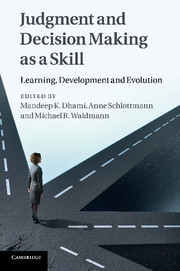Book contents
- Frontmatter
- Contents
- Figures
- Contributors
- Preface
- Acknowledgments
- Chapter cross-reference table
- Part I Evolutionary and neural bases of JDM
- Part II Developmental approaches to JDM
- Part III Learning JDM
- Part IV Improving and aiding JDM
- 9 Improving judgment and decision making through communication and representation
- 10 Aiding judgment and decision making
- Conclusion
- Index
- References
10 - Aiding judgment and decision making
Published online by Cambridge University Press: 05 December 2011
- Frontmatter
- Contents
- Figures
- Contributors
- Preface
- Acknowledgments
- Chapter cross-reference table
- Part I Evolutionary and neural bases of JDM
- Part II Developmental approaches to JDM
- Part III Learning JDM
- Part IV Improving and aiding JDM
- 9 Improving judgment and decision making through communication and representation
- 10 Aiding judgment and decision making
- Conclusion
- Index
- References
Summary
Introduction
Judgment and decision-making skill is a central theme of this book. This implies that people sometimes consistently carry out judgment and decision-making tasks poorly. In some instances, normal psychological development, practice, and training can be expected to yield stronger skills and thus better performance over time. But there remains the challenge of achieving good judgments and decisions for pressing current situations – “right now.” Moreover, some problems are so difficult that it is unrealistic to expect that any human being, left to his or her own devices, could ever acquire the ability to produce adequate decisions. These facts have motivated the development of “decision aids,” which are procedures or devices that are intended to improve the quality of people’s decisions and are the subject of this chapter.
The chapter addresses several questions, which are considered in successive sections: This is the focal question for the first section: “What do common decision aids look like?” The next section considers this query: “What is the significance of decision aids for scholarship on fundamental judgment and decision-making phenomena – including skill?” The third section pursues the following question: “What exactly are ‘decisions,’ ‘judgments,’ and the high level of ‘decision quality’ that decision aids (should) seek?” The fourth and largest section is the heart of the chapter, and it confronts this question: “How can we determine what, specifically, a decision aid needs to accomplish in a given situation?” The last section summarizes the chapter. It also offers reflections on a final question that challenges every decision aid developer: “How can we ‘sell’ decision aids to the people who need them most?”
- Type
- Chapter
- Information
- Judgment and Decision Making as a SkillLearning, Development and Evolution, pp. 259 - 288Publisher: Cambridge University PressPrint publication year: 2011

